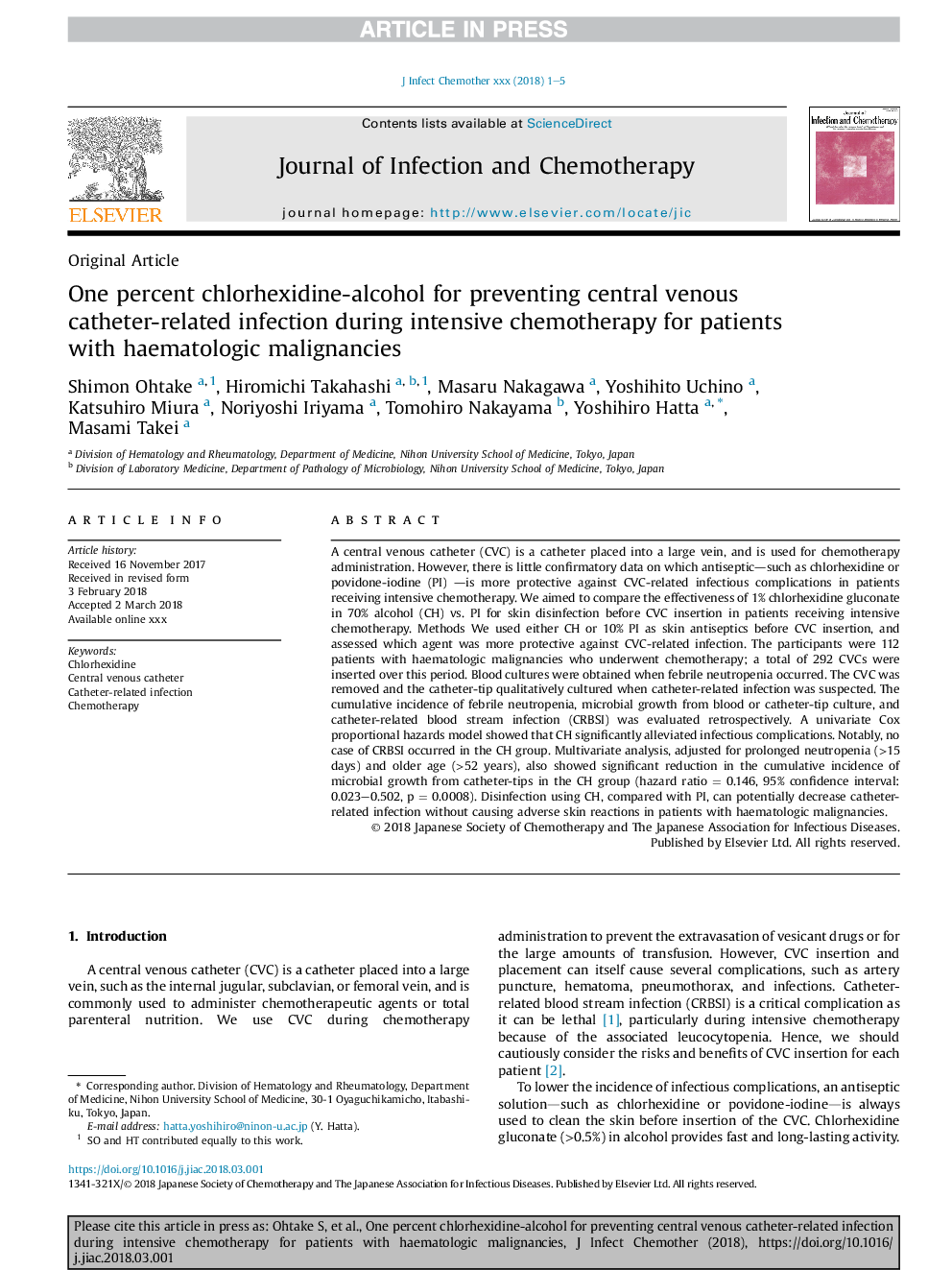| کد مقاله | کد نشریه | سال انتشار | مقاله انگلیسی | نسخه تمام متن |
|---|---|---|---|---|
| 8740604 | 1592421 | 2018 | 5 صفحه PDF | دانلود رایگان |
عنوان انگلیسی مقاله ISI
One percent chlorhexidine-alcohol for preventing central venous catheter-related infection during intensive chemotherapy for patients with haematologic malignancies
ترجمه فارسی عنوان
یک درصد کلرهگزیدین الکل برای جلوگیری از عفونت ناشی از کاتتر ورید مرکزی در طی شیمیدرمانی شدید برای بیماران مبتلا به بدخیمی های هماتولوژیک
دانلود مقاله + سفارش ترجمه
دانلود مقاله ISI انگلیسی
رایگان برای ایرانیان
کلمات کلیدی
کلرهگزیدین، کاتتر وریدی مرکزی، عفونت مرتبط با کاتتر، شیمی درمانی،
موضوعات مرتبط
علوم زیستی و بیوفناوری
ایمنی شناسی و میکروب شناسی
میکروبیولوژی و بیوتکنولوژی کاربردی
چکیده انگلیسی
A central venous catheter (CVC) is a catheter placed into a large vein, and is used for chemotherapy administration. However, there is little confirmatory data on which antiseptic-such as chlorhexidine or povidone-iodine (PI) -is more protective against CVC-related infectious complications in patients receiving intensive chemotherapy. We aimed to compare the effectiveness of 1% chlorhexidine gluconate in 70% alcohol (CH) vs. PI for skin disinfection before CVC insertion in patients receiving intensive chemotherapy. Methods We used either CH or 10% PI as skin antiseptics before CVC insertion, and assessed which agent was more protective against CVC-related infection. The participants were 112 patients with haematologic malignancies who underwent chemotherapy; a total of 292 CVCs were inserted over this period. Blood cultures were obtained when febrile neutropenia occurred. The CVC was removed and the catheter-tip qualitatively cultured when catheter-related infection was suspected. The cumulative incidence of febrile neutropenia, microbial growth from blood or catheter-tip culture, and catheter-related blood stream infection (CRBSI) was evaluated retrospectively. A univariate Cox proportional hazards model showed that CH significantly alleviated infectious complications. Notably, no case of CRBSI occurred in the CH group. Multivariate analysis, adjusted for prolonged neutropenia (>15 days) and older age (>52 years), also showed significant reduction in the cumulative incidence of microbial growth from catheter-tips in the CH group (hazard ratio = 0.146, 95% confidence interval: 0.023-0.502, p = 0.0008). Disinfection using CH, compared with PI, can potentially decrease catheter-related infection without causing adverse skin reactions in patients with haematologic malignancies.
ناشر
Database: Elsevier - ScienceDirect (ساینس دایرکت)
Journal: Journal of Infection and Chemotherapy - Volume 24, Issue 7, July 2018, Pages 544-548
Journal: Journal of Infection and Chemotherapy - Volume 24, Issue 7, July 2018, Pages 544-548
نویسندگان
Shimon Ohtake, Hiromichi Takahashi, Masaru Nakagawa, Yoshihito Uchino, Katsuhiro Miura, Noriyoshi Iriyama, Tomohiro Nakayama, Yoshihiro Hatta, Masami Takei,
